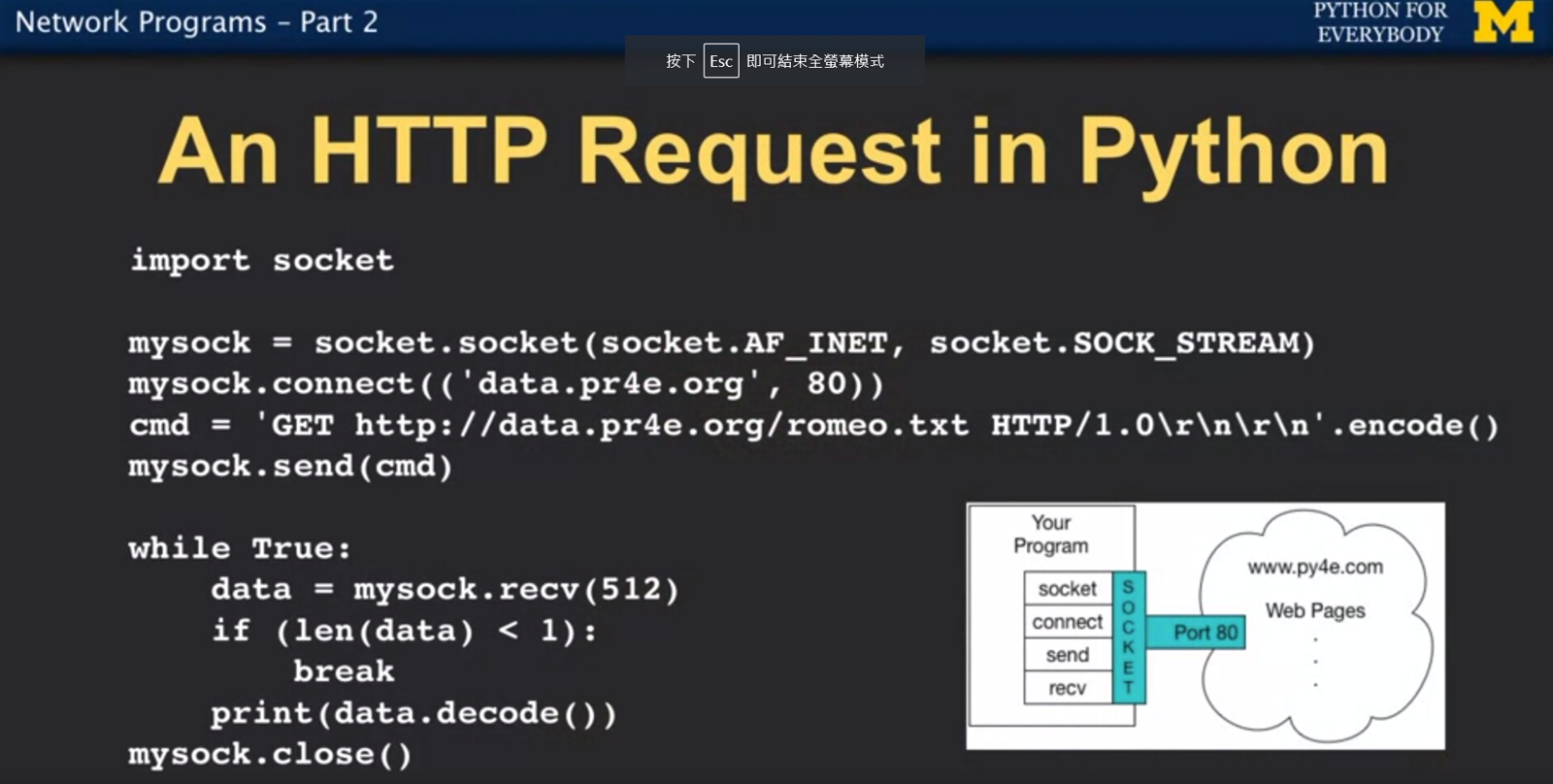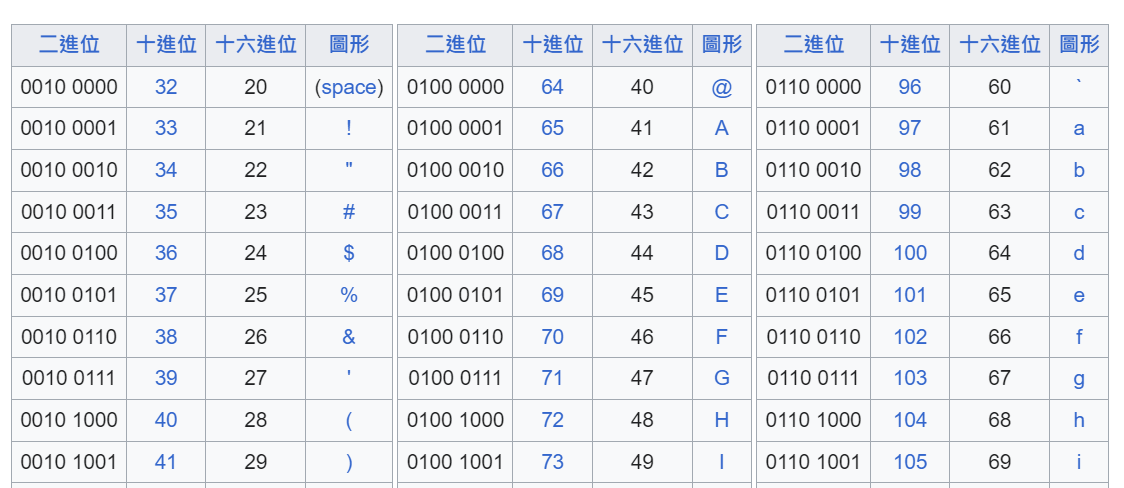PY - Access Web Data
Regular Expressions
re.search:返回第一個找到的項目。相當於re.find。re.finadall:搜索所有匹配的項目。
import re
fh = open('regex_sum_1927563.txt')
content = fh.read()
regFh = re.findall('[0-9]+', content)
nums = 0
for i in regFh:
nums += int(i)
print(nums)
| RegEx | 解釋 |
|---|---|
a | 匹配字符串中的 "a"。 |
^a | 匹配以 "a" 開頭項目。 |
b$ | 匹配以字母 "b" 結尾的字串。 |
. | 匹配任何單個字符,如字串 "abc" 可以用 a.c 匹配整個字串。 |
+ | 表示前面的規則可以重複一次或多次,如 a+ 將匹配 "a"、"aa"、"aaa" 等。 |
+? | 非貪婪匹配,會將匹配的字符限制在最小可能的範圍,如 a+? 匹配 "aaa" 會只返回 "a"。 |
* | 表示前面的規則可以重複 0 次或多次,用法跟 + 相同。 |
*? | 非貪婪匹配。 |
\s | 匹配空白字串,如 ^\s+ 可以匹配以空白開頭的字串。 |
\S | 匹配非空白字串。 |
[abc] | 匹配群組內任一字符。 |
[^abc] | 匹配群組以外的字符。 |
() | 分組,如 (abc)+ 將匹配連續出現的 "abcabc"。 |
Sockets
import socket
# 創建 socket
mysock = socket.socket(socket.AF_INET, socket.SOCK_STREAM)
# 連結伺服器與端口
mysock.connect(('data.pr4e.org', 80))
cmd = 'GET http://data.pr4e.org/intro-short.txt HTTP/1.0\r\n\r\n'.encode()
mysock.send(cmd)
while True:
# 每次接收最多 512 個字節的數據
data = mysock.recv(512)
if len(data) < 1:
break
print(data.decode(),end='')
mysock.close()
下圖為 Python for everybody 課程影片截圖,用繪圖的方式方常快速理解 socket 和上述程式碼在網路溝通中扮演的角色。

Unicode
ASCII
早期常用的字符編碼方式,以 128 個數字聯繫了 26 個大寫字母、26 個小寫字母、10 個數字、標點符號、控制字符等。每個字符都有一個唯一的 7 位二進制編碼,這樣的設計使得 ASCII 字�符可以直接映射到一個字節(byte,8 位)的二進制數據中。

這也說明了為什麼 print('H' < 'h') 會得到 True,因為代表 h 的數字是 104,大於 H 的 72。
print(ord('H'))
# 72
Unicode
解決 ASCII 無法儲存其他語系字符的問題。UTF-8 是現在常用的編碼方式。
下圖解釋了為何上述程式碼需要進行 encode 和 decode。

Urllib + BeautifulSoup
Urllib 是 Python 的一個標準庫,專門用來爬取網頁資源。
BeautifulSoup 則是 Python 用來解析獲得的 HTML 或 XML 資料的 library。
pip install beautifulsoup4
from urllib.request import urlopen
from bs4 import BeautifulSoup
import ssl
# Ignore SSL certificate errors
ctx = ssl.create_default_context()
ctx.check_hostname = False
ctx.verify_mode = ssl.CERT_NONE
url = "http://py4e-data.dr-chuck.net/comments_42.html"
html = urlopen(url, context=ctx).read()
soup = BeautifulSoup(html, "html.parser")
tags = soup('span')
total = 0
for tag in tags:
try:
num = int(tag.contents[0])
total += num
except:
continue
print(total)
XML
早期泛用的跨平台間的交換數據格式,長得跟 HTML 很像,現在依舊有部分平台或伺服器沿用 XML 做資料傳輸。
在 Python 中可以利用 xml.etree.ElementTree 來把 XML 解析成 element tree (就像 HTML 可以解析成 DOM tree) 來方便做資料的解析。
import urllib.request, urllib.parse, urllib.error
import ssl
import xml.etree.ElementTree as ET
ctx = ssl.create_default_context()
ctx.check_hostname = False
ctx.verify_mode = ssl.CERT_NONE
url = 'http://py4e-data.dr-chuck.net/comments_1927567.xml'
data = urllib.request.urlopen(url, context=ctx).read()
tree = ET.fromstring(data)
counts = tree.findall('.//count')
total = 0
for count in counts:
total += int(count.text)
print(total)
JSON
現在較泛用的跨平台資料交換格式,因為比 XML 更加輕量與便於解析,所以使用率超越 XML。
在 Python 中可以透過 json 套件來解析 JSON。
import urllib.request, urllib.parse, urllib.error
import ssl
import json
ctx = ssl.create_default_context()
ctx.check_hostname = False
ctx.verify_mode = ssl.CERT_NONE
url = 'http://py4e-data.dr-chuck.net/comments_1927568.json'
data = urllib.request.urlopen(url, context=ctx).read()
info = json.loads(data)
total = 0
for item in info['comments']:
total += item['count']
print(total)
課程總結
網路間的溝通,綜合以上從 socket 到 JSON,大致可以把流程歸納如下:
- 資料要送出去時還是 XML 或 JSON,先轉為 Unicode,再 encode 成 bytes。
- 透過 socket 將請求或資料送出。
- 接收方收到後,將 bytes 給解碼成 Unicode,在解析成 XML 或 JSON。
或許會有疑問為何使用 Urllib 時也沒寫到 socket,但一樣能取回資料?
那是因為 socket 是很底層的邏輯,當使用 Urllib 這個套件時,其實 socket 的邏輯已經封裝在裡面了。
